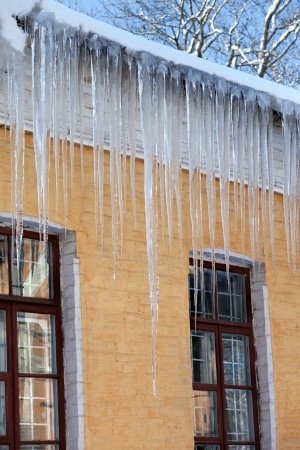Snow and ice often make driving treacherous in winter. However, the danger these elements pose doesn’t end there. Snow and ice can also cause expensive damage to your home and roof. Let’s examine how ice dams form, how you can prevent them and what to do get rid of one before it causes serious damage.
The Formation of Ice Dams
During the winter, ice and snow build on the roof of your home and garage. When the layer of snow on the roof melts due to the heat rising in the attic of your home, water pools along the edge of the roof, where the temperature is much cooler. There, it refreezes, causing ice dams—a mound of ice that starts along the eaves of the roof and spreads upward.
 This formation of ice, which often traps pools of water underneath it, can cause substantial damage to the exterior and interior of your home. Gutters and downspouts blocked by ice prevent water from draining properly, causing icicles to form overhead, which pose a danger to people and property. The weight and expansion of the ice in gutters and downspouts can damage or dislodge them from the house. If the ice dam breaks free, shingles may be ripped off, along with the ice. Anyone or anything in its path below,including people, pets, shrubbery or fencing, may be harmed.
This formation of ice, which often traps pools of water underneath it, can cause substantial damage to the exterior and interior of your home. Gutters and downspouts blocked by ice prevent water from draining properly, causing icicles to form overhead, which pose a danger to people and property. The weight and expansion of the ice in gutters and downspouts can damage or dislodge them from the house. If the ice dam breaks free, shingles may be ripped off, along with the ice. Anyone or anything in its path below,including people, pets, shrubbery or fencing, may be harmed.
Meltwater trapped underneath the ice dam seeps underneath shingles, loosening them. Pooled water can penetrate the interior walls and ceilingsof your home or garage.Invading meltwater compromises insulation, stains and deteriorates drywall and causes paint to bubble and peel. If the leak is persistent, it can damage flooring, furniture and other items. Mold and mildew will form on drywall and insulation that stays damp for long periods of time. Affected wood may begin to rot, compromising the integrity of your roof.
How to Prevent Ice Dams
For a permanent solution to hazardous ice dams, address the primary cause—poorly insulated attic space. Install a ridge vent and soffit vents to circulate cold air beneath the roof.Cap the attic hatch and sealaround chimneys, exhaust fans, ducts and other spaces from which heat might leak.Insulate ducts, and use a fire-barrier sealant to caulk around vent pipes and electrical cords. In addition to preventing ice dams, proper insulation and ventilation will keep your attic warmer in winter and cooler in summer, reducing heating and cooling costs.
If your furnace is located in the attic, it may not be possible to permanently prevent ice dams. (See short-term solutions below.) Still, proper ventilation and insulation of the attic will reduce the likelihood of ice dam formation. Consult a contractor to insulate and ventilate your attic safely and according to code.
Short-term ice dam prevention begins before the first snowfall. Provide a clear pathway for melting ice in winter by clearing leaves from gutters and downspouts during autumn. After a big snowfall, use a snow removal tool with a long handle to remove snow from the safety of the ground. Removing snow from the roof will also help prevent roof collapses caused by heavy, wet snow.
Alternately, heat cables can be installed along the edge of the roof in a zigzag pattern and down the nearest downspout. From there, the heat cable must be plugged into a GFCI outlet.The heated cables melt snow and prevent ice dams. However, when snowfall is particularly heavy, heat cables can cause meltwater to pool, causing leaks. Be sure to install and operate heat cables according to manufacturer’s instructions and monitor their use carefully.
Eliminating an Ice Dam
What, though, if an ice dam has already formed on your roof?
- Try aiming a box fan at the spot of the interior leak. This should lower the temperature of the roof and stop the leak.
- If working from the inside doesn’t help, consider hiring an experienced contractor to remove the ice dam safely.
- If hiring a contractor isn’t an option, be mindful that working on a ladder in icy conditions can be extremely dangerous. Wear shoes with rubber soles and proceed carefully. Make sure that people or pets are not underneath the ice dam while you’re working.
- Melt the ice by filling the leg of an old pair of nylons with calcium chloride ice melter. (Do not use rock salt, as it will damage the metal, paint and shrubbery beneath.) Lay the nylon leg, filled with an ice-melt mixture and tied off at both ends, vertically across the dam. The snow and ice will melt, creating a channel for the water underneath.
- Don’t use sharp tools like a pick or hatchet to chip away at the ice dam. There’s a good chance you’ll damage the shingles.
Ice dams cause millions of dollars in damages each year. Insurance can recoup some of the costs. However, prevention is the key. Insulate, seal and ventilate your attic. During fall, remove leaves from gutters and downspouts to give meltwater a clear path. Remove heavy snowfall from your roof to help prevent both ice dams and roof collapse.
Next time we’ll talk about how to prevent ice on walkways, driveways and around the door of your garage.